"EL OCIO DESMEDIDO" : Excessive Leisure and Ecological
Destruction on Puerto Rico’s Coasts
"EL OCIO DESMEDIDO" : Excessive Leisure and Ecological
Destruction on Puerto Rico’s Coasts
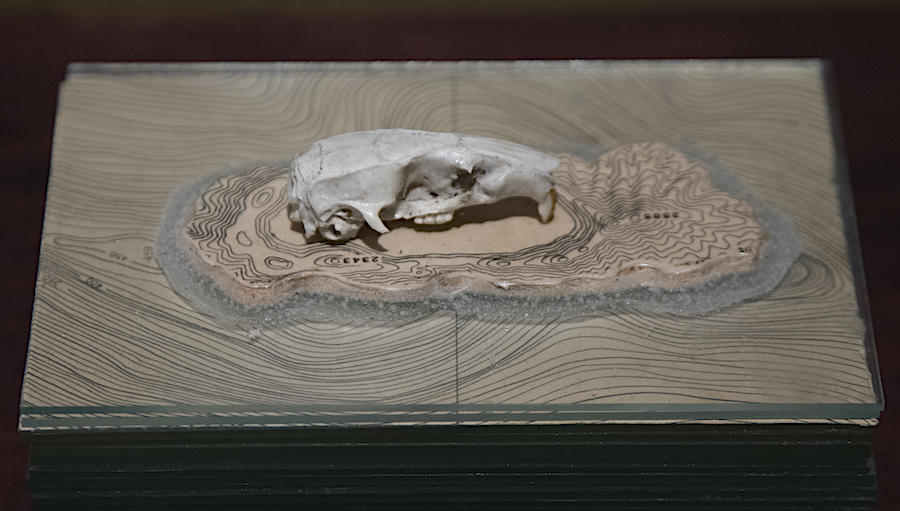
Dhara Rivera, Habitante. 2019. Mixed media. Collection of the artist. Image courtesy of the artist. Photograph by
Javier Del Valle (Galería Fundación Angel Ramos, February 15, 2019).
An Interview with Dhara Rivera
by Charlotte Rogers
Charlotte Rogers: Your 2019 installation Abra Paisaje features Cayo Aurora, more popularly known as Guilligan’s Island, a small island off the southern coast of Puerto Rico that has been a popular day trip for snorkeling and barbecues among school groups, tourists, and locals on vacation. In 2018, the island was overrun by rats attracted to the animal bones and other refuse left by visitors and had to close for fumigation, a circumstance you allude to in pieces like Habitante in the Abra Paisaje installation. How did you decide to make art about Guilligan’s Island?
Dhara Rivera: The way I work is never linear but rather tied to personal experience. I often approach a topic from an affective perspective, when I feel a certain attraction, curiosity, or fascination. I had visited Guilligan’s island for many years and I saw how it changed from a rarely visited place to one used and abused by too many visitors. The quantity of human visitors was overwhelming the island. On a visit in 2017, I found the bones of rats mingled with the dried corals among the mangrove roots. I was shocked by the huge number of bones mixed in and camouflaged by the rest of the ecosystem. It made me understand how profoundly we are changing the archaeological, anthropological, biological, and geographical reality of the island. That’s where the piece began. It sparked my research into “el ocio desmedido,” or the excessive leisure that verges on destruction of the environment.
"...we are changing the archaeological, anthropological, biological, and geographical reality of the island."
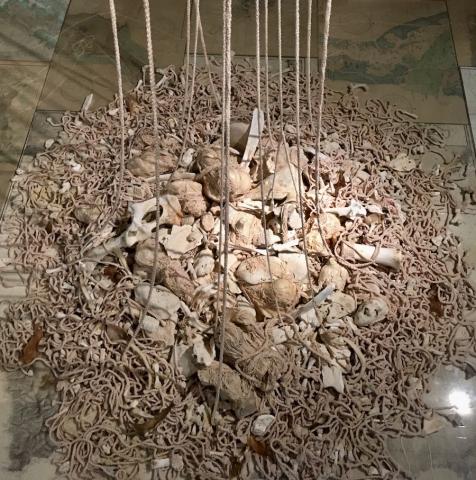
Dhara Rivera, Abra paisaje, 2019. Mixed media. Collection of the artist. Image courtesy of the artist. Photograph by Javier Del Valle. (Galería Fundación Angel Ramos, February 15, 2019).
CR: The Spanish-language title of the installation, Abra Paisaje, can be interpreted in multiple ways, both as “Open, Landscape” as in “Open, Sesame” and “Will There Be a Landscape?” What possibilities does this title open up for the viewer of the exhibition?
DR: The title opens up many possibilities. My work always raises questions and sparks curiosity; the word “abra” seeks to open up a conversation. On the other hand, I wanted to play with language a bit, so the question “¿habrá paisaje?” depends on having someone or something look at the landscape, to see it. So the title asks the question, “who will be there and who will not?” It’s a bit like the ending of the Werner Herzog film Cave of Forgotten Dreams (2011), in which lizards are left in the cave after the humans have gone.
CR: Unlike a lot of didactic or apocalyptic art about waste and human-induced climate change, Abra Paisaje uses bright colors and has a playful, ambiguous tone. Why do you approach climate catastrophe in this way?
DR: I like to walk the line between the playful and the apocalyptic, instead of opting for one or the other. I stay on that knife-edge or balance beam, because the piece is both attractive and terrifying, terrible and marvelous; the world is made up of the dynamics. My work is fascinated by the complexity of life beyond the human. We can’t see our situation as just the end of the world, but also as an opportunity to perceive the beauty of life beyond the human.
CR: In January of 2020, a 6.4 magnitude earthquake and its aftershocks hit Guánica, leveling homes and school buildings in the south of Puerto Rico and compounding the damage done by 2017’s Hurricane
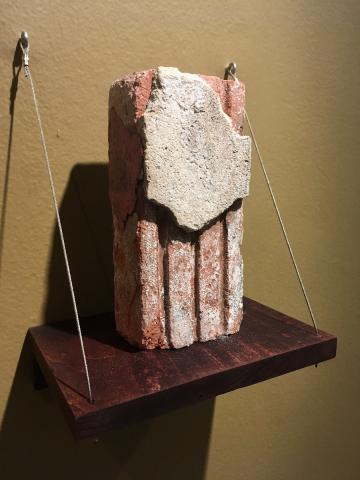
Dhara Rivera, bbc, 2019. Mixed media. Collection of the artist. Image courtesy of the artist. Photograph by Javier Del Valle. (Galería Fundación Angel Ramos, February 15, 2019).
María, from which the island has still not recovered. Guilligan’s Island subsisted during the earthquake, destroying the docks, barbecues, and signage installed by the Department of Natural Resources (DRNA). Much of the island now lies several meters underwater, still visible but inaccessible to humans. The once-frequent ferry service from the mainland has ceased operations. Do you feel that Abra Paisaje in some way anticipates the new configuration of Guilligan’s island? How might the piece and the new ecology of Guilligan’s speak differently to an audience now in comparison to 2019?
DR: Now what we have is evidence of the lasting effects of some many thousands of people going to Guilligan’s. Seeing the barbeque grills underwater is a teachable moment, for sure. But in 2019 the piece already anticipated this moment in which the island would no longer have a human presence. I think it is useful to see ourselves from a hypothetical future perspective in which we are no longer damaging our surroundings. It raises the possibility of a recuperation for the ecosystem.
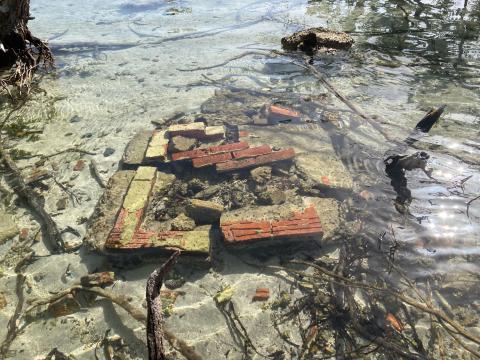
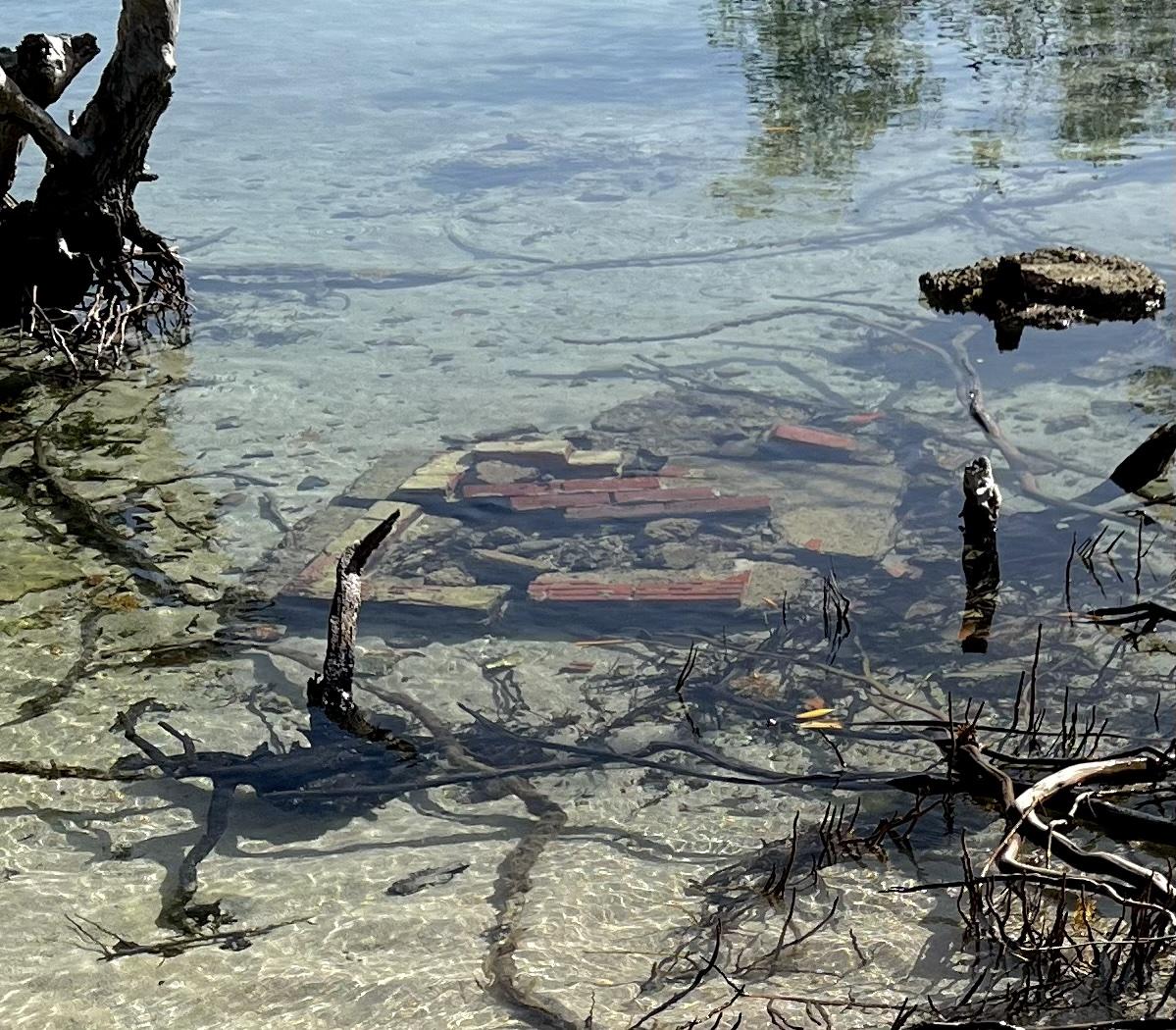
Submerged bbq grills at Guilligan’s Island, detail. Image courtesy of the artist.
Submerged bbq grills at Guilligan’s Island. Image courtesy of the artist.
Abra Paisaje (2019) was first exhibited at the Galería SalaFAR. The central piece in the installation was purchased by the Instituto de Cultura Puertorriqueña in 2022. A selection of works from the installation is currently on display at the Museum of Arte de Puerto Rico.
Read more about Dhara Rivera's work in Charlotte Rogers, "A Multispecies Caribbean: The Aesthetics of Ecological Reinvention in Art by Dhara Rivera." Small Axe 73, March 2024.
Artist and Author Bios
Dhara Rivera is a multimedia artist living and working in Puerto Rico. She holds Bachelor degrees in Humanities and Sculpture from the University of Puerto Rico (UPR) and Pratt Institute in New York. She graduated from Hunter College with a Masters Degree in Sculpture and later, she completed the first year of doctoral studies in the Public Space and Art Program of the University of Barcelona, Spain. Over the last two decades Rivera’s work has focused on bodies of water and their place in society. Her work takes a poetical approach to interweaving social, political, and historical aspects into each of her ecological art projects.
Charlotte Rogers is Associate Professor of Spanish at the University of Virginia. She specializes in twentieth- and twenty-first-century Latin America and the Caribbean, with a comparative focus on representations of the tropics in literature, art, and culture. She is the author of Jungle Fever: Exploring Madness and Medicine in Twentieth-Century Tropical Narratives (Vanderbilt University Press, 2012) and Mourning El Dorado: Literature and Extractivism in the American Tropics (University of Virginia Press, 2019). Mourning El Dorado received Honorable Mention in the Latin American Studies Association Amazonia section Best Book Prize competition in 2020. Her articles appear in journals including PMLA, ISLE: Interdisciplinary Studies in Literature and the Environment, Revista de Estudios Hispánicos, Bulletin of Hispanic Studies, Hispania, MLN and the Revista Canadiense de Estudios Hispánicos. She serves on the Editorial Boards of ISLE of the Revista de Estudios Hispánicos.